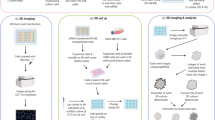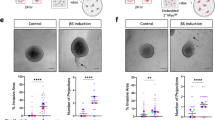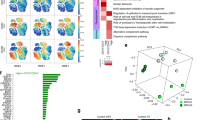Abstract
Breast cancer and precancer cells are influenced by important paracrine regulation from the breast microenvironment, which might be as great a determinant of breast cancer behavior as the specific oncogenic or tumor-suppressive alterations occurring within malignant breast cells. Myoepithelial cells exert profound effects on breast tumor cell behavior, and lie in juxtaposition to abnormally proliferating breast epithelial cells in precancerous disease states such as ductal carcinoma in situ (DCIS). Myoepithelial cells also form a natural border separating breast epithelial cells from stromal angiogenesis. These anatomical relationships suggest that myoepithelial cells might inhibit both the progression of DCIS to invasive breast cancer, and carcinoma-induced angiogenesis. Our ability to study myoepithelial cells has been fostered by recent technical advances in cell selection and sorting procedures, improved selective media, and high throughput technologies, which are able to assess the gene and protein expression profiles within cells. In addition, the establishment of a number of immortalized cell lines and xenografts of myoepithelial cells derived from benign human myoepithelial tumors of diverse sources has provided a self-renewing cell source through which to study the phenotype of myoepithelial cells. Studies of primary and immortalized myoepithelial cell lines indicate that these cells exhibit a natural tumor suppressor function. Functional studies show that these cells have anti-invasive and antiangiogenic phenotypes.
Key Points
-
Myoepithelial cells surround both normal ducts and precancerous lesions of the breast, and form a natural border separating epithelial cells from stromal cells
-
By forming this natural border, myoepithelial cells are thought to negatively regulate tumor invasion, angiogenesis and metastasis
-
Tumors of the myoepithelium are uncommon and usually benign, although highly aggressive malignant myoepitheliomas can occasionally occur, which have a poor prognosis
-
Myoepithelial cells function as both natural paracrine as well as autocrine tumor suppressors
-
Myoepithelial lines retain the ability to secrete and accumulate an abundant extracellular matrix containing both basement membrane and non-basement membrane components
This is a preview of subscription content, access via your institution
Access options
Subscribe to this journal
Receive 12 print issues and online access
$209.00 per year
only $17.42 per issue
Buy this article
- Purchase on Springer Link
- Instant access to full article PDF
Prices may be subject to local taxes which are calculated during checkout












Similar content being viewed by others
References
Liu HL et al. (2005) Proliferation and polarity in breast cancer: untying the gordian knot. Cell Cycle 4: 646–649
Kim JB et al. (2005) Tumour–stromal interactions in breast cancer: the role of stroma in tumourigenesis. Tumour Biol 26: 173–185
Rizki A and Bissell MJ (2004) Homeostasis in the breast: in takes a village. Cancer Cell 6: 1–2
Allinen M et al. (2004) Molecular characterization of the tumor microenvironment in breast cancer. Cancer Cell 6: 17–32
Hu M et al. (2005) Distinct epigenetic changes in the stromal cells of breast cancers. Nat Genetics 37: 899–905
Sternlicht MD et al. (1996) Establishment and characterization of a novel human myoepithelial cell line and matrix-producing xenograft from a parotid basal cell adenocarcinoma. In Vitro Cell Dev Biol 32: 550–563
Lakhani SR and O'Hare MJ (2000) The mammary myoepithelial cell—Cinderella or ugly sister? Breast Cancer Res 3: 1–4
Jones C et al. (2004) Expression profiling of purified normal human luminal and myoepithelial breast cells: identification of novel prognostic markers for breast cancer. Cancer Res 64: 3037–3045
Gudjonsson T et al. (2002) Normal and tumor-derived myoepithelial cells differ in their ability to interact with luminal breast epithelial cells for polarity and basement membrane deposition. J Cell Science 115: 39–50
Nguyen M et al. (2000) The human myoepithelial cell displays a multifaceted anti-angiogenic phenotype. Oncogene 19: 3449–3459
Alford D and Taylor-Papadimitriou J (1996) Cell adhesion molecules in the normal and cancerous mammary gland. J Mammary Gland Biol Neoplasia 1: 207–218
Adriance MC et al. (2005) Myoepithelial cells: good fences make good neighbors. Breast Cancer Res 7: 190–197
Gudjonsson T et al. (2003) To create the correct microenvironment: three-dimensional heterotypic collagen assays for human breast epithelial morphogenesis and neoplasia. Methods 30: 247–255
Jolicoeur F et al. (2003) Basal cells of second trimester fetal breasts: immunohistochemical study of myoepithelial precursors. Pediatr and Dev Path 6: 398–413
Deugnier MA et al. (2002) The importance of being a myoepithelial cell. Breast Cancer Res 4: 224–230
Fridriksdottir AJR et al. (2005) Maintenance of cell type diversification in the human breast. J Mammary Gland Biol Neoplasia 10: 61–74
Sternlicht M et al. (1996) Characterizations of the extracellular matrix and proteinase inhibitor content of human myoepithelial tumors. Lab Invest 74: 781–796
Sternlicht M and Barsky SH (1997) The myoepithelial defense: a host defense against cancer. Med Hypotheses 48: 37–46
Sternlicht MD et al. (1997) The human myoepithelial cell is a natural tumor suppressor. Clin Cancer Res 3: 1949–1958
Bissell MJ and Labarge MA (2005) Context, tissue plasticity, and cancer: are tumor stem cells also regulated by the microenvironment? Cancer Cell 7: 17–23
Xiao G et al. (1999) Suppression of breast cancer growth and metastasis by a serpin myoepithelium-derived serine proteinase inhibitor expressed in the mammary myoepithelial cells. Proc Natl Acad Sci USA 96: 3700–3705
Jones JL et al. (2003) Primary breast myoepithelial cells exert an invasion-suppressor effect on breast cancer cells via paracrine down-regulation of MMP expression in fibroblasts and tumour cells. J Pathol 201: 562–572
Jolicoeur F et al. (2002) Multifocal, nascent, and invasive myoepithelial carcinoma (malignant myoepithelioma) of the breast: an immunohistochemical and ultrastructural study. Int J Surg Pathol 10: 281–291
Jones C et al. (2001) CGH analysis of ductal carcinoma of the breast with basaloid/myoepithelial cell differentiation. Br J Cancer 85: 422–427
Scarpellini F et al. (1997) Malignant myoepithelioma associated with in situ and invasive ductal carcinoma: description of a case and review of the literature. Pathologica 89: 420–424
Foschini MP and Eusebi V (1998) Carcinomas of the breast showing myoepithelial cell differentiation. Virchows Arch 432: 303–310
Jones C et al. (2000) Comparative genomic hybridization analysis of myoepithelial carcinoma of the breast. Lab Invest 80: 831–836
Teuliere J et al. (2005) Targeted activation of β-catenin signaling in basal mammary epithelial cells affects mammary development and leads to hyperplasia. Development 132: 267–277
Cardiff RD et al. (2000) The mammary pathology of genetically engineered mice: the consensus report and recommendations from the Annapolis meeting. Oncogene 19: 966–967
Cavenee WK (1993) A siren song from tumor cells. J Clin Invest 91: 3
Safarians S et al. (1996) The primary tumor is the primary source of metastasis in a human melanoma/SCID model: implications for the direct autocrine and paracrine epigenetic regulation of the metastatic process. Int J Cancer 66: 151–158
Liotta LA et al. (1991) Cancer metastasis and angiogenesis: an imbalance of positive and negative regulation. Cell 64: 327–336
Folkman J and Klagsbrun M (1987) Angiogenic factors. Science 235: 442–447
Cornil I et al. (1991) Fibroblast cell interactions with human melanoma cells affect tumor cell growth as a function of tumor progression. Proc Natl Acad Sci USA 88: 6028–6032
Sgroi DC et al. (1999) In vivo gene expression profile analysis of human breast cancer progression. Cancer Res 59: 5656–5661
Barsky SH (2003) Myoepithelial mRNA expression profiling reveals a common tumor-suppressor phenotype. Exp Mol Path 74: 113–122
Guelstein VI et al. (1993) Myoepithelial and basement membrane antigens in benign and malignant human breast tumors. Int J Cancer 53: 269–277
Cutler LS (1990) The role of extracellular matrix in the morphogenesis and differentiation of salivary glands. Adv Dent Res 4: 27–33
Gudjonsson T et al. (2004) Immortalization protocols used in cell culture models of human breast morphogenesis. Cell Mol Life Sci 61: 2523–2534
Liu S et al. (2005) Mammary stem cells, self-renewal pathways and carcinogenesis. Breast Cancer Res 7: 86–95
Dontu G and Wicha MS (2005) Survival of mammary stem cells in suspension culture: implications for stem cell biology and neoplasia. J Mammary Gland Biol Neoplasia 10: 75–86
Dontu G et al. (2003) In vitro propagation and transcriptional profiling of human mammary stem/progenitor cells. Genes Dev 17: 1253–1270
Gudjonsson T et al. (2002) Isolation, immortalization and characterization of a human breast epithelial cell line with stem cell properties. Genes Dev 16: 693–706
Pechoux P et al. (1999) Human mammary luminal epithelial cells contain progenitors to myoepithelial cells. Dev Biol 206: 88–89
Petersen OW et al. (2003) Epithelial progenitor cell lines as models of normal breast morphogenesis and neoplasia. Cell Prolif 36 (Suppl 1): S33–S44
Kedeshian P et al. (1998) Humatrix, a novel myoepithelial matrical gel with unique biochemical and biological properties. Cancer Lett 123: 215–226
Zhang M et al. (2000) Maspin is an angiogenesis inhibitor. Nat Med 6: 196–199
Nguyen M et al. (2000) The human myoepithelial cell displays a multifaceted anti-angiogenic phenotype. Oncogene 19: 3449–3459
Shao ZM et al. (2000) Tamoxifen enhances myoepithelial cell suppression of human breast carcinoma progression by two different effector mechanisms. Cancer Lett 157: 133–144
Love SM and Barsky SH (1996) Breast-duct endoscopy to study stages of cancerous breast disease. Lancet 348: 997–999
Perou CM et al. (2000) Molecular portraits of human breast tumors. Nature 406: 747–752
Sorlie T et al. (2001) Gene expression patterns of breast carcinomas distinguish tumor subclasses with clinical implications. Proc Natl Acad Sci USA 98: 10869–10874
Acknowledgements
This work was supported by USPHS grants CA40225, CA01351 and CA71195, and Department of Defense grant DAMD17-00-1-0176, all of which were awarded to SH Barsky.
Author information
Authors and Affiliations
Corresponding author
Ethics declarations
Competing interests
The authors declare no competing financial interests.
Supplementary information
Rights and permissions
About this article
Cite this article
Barsky, S., Karlin, N. Mechanisms of Disease: breast tumor pathogenesis and the role of the myoepithelial cell. Nat Rev Clin Oncol 3, 138–151 (2006). https://doi.org/10.1038/ncponc0450
Received:
Accepted:
Issue Date:
DOI: https://doi.org/10.1038/ncponc0450
This article is cited by
-
Re-evaluation of the myoepithelial cells roles in the breast cancer progression
Cancer Cell International (2022)
-
LPA receptor activity is basal specific and coincident with early pregnancy and involution during mammary gland postnatal development
Scientific Reports (2016)
-
Breast cancer risk factor associations differ for pure versus invasive carcinoma with an in situ component in case–control and case–case analyses
Cancer Causes & Control (2016)
-
The EGF signaling pathway influences cell migration and the secretion of metalloproteinases by myoepithelial cells in pleomorphic adenoma
Tumor Biology (2015)
-
Expression and role of fibroblast activation protein-alpha in microinvasive breast carcinoma
Diagnostic Pathology (2011)



